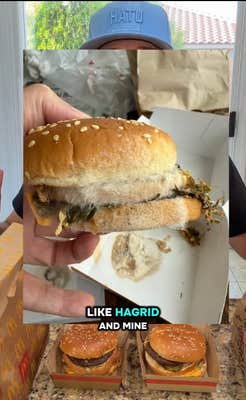
“Mine isn’t food”: American Big Mac still looks fresh after 30 days, Japanese one molds—but the reason might be boring, not sinister

Two TikTokers on opposite sides of the world compared results after letting their countries’ McDonald’s Big Macs sit out for 30 days. This is another in a long line of experiments testing whether and how much fast food products decay, with McDonald’s being one of the primary targets ever since the release of Super Size Me.
There may, however, be a non-chemical explanation for why some burgers rot and others don’t.
America vs. Japan: A Big Mac experiment
Last week, TikToker Joe Orton (@yerbajoemate) posted the results of the experiment he ran with @ttsuchiya686 to see if a Big Mac from Japan would decompose, or stay looking fresh like the ones from the U.S. Both waited 30 days after buying their burgers and displayed the results for their viewers.
The American has performed several experiments like this already, comparing Big Macs to entrees from other fast food chains, but wanted to see whether the odd tendency for the McDonald’s burgers to avoid decay was a purely U.S. phenomenon. He showed his 30-day-old Big Mac first, and it looked perfectly new.
Its Japanese counterpart did not fare so well.

“Mine’s all moldy and hairy,” said @ttsuchiya686. “Ew, stinks.”
Both TikTokers concluded that there must be something wrong with Big Macs made in the U.S. specifically.
“Why does Japan’s look like Hagrid and mine looks like it got Botox?” Orton asked.
“Mine isn’t food,” he concluded. “This is industrialized. This is engineered to last forever, not to feed you.”
The pair went on to advertise a “protocol” they’re selling that claims to make it “easier to be healthy.” This brings into question whether this was a sincere experiment or merely a lead-up to a sales pitch.
@yerbajoemate 🇺🇸 🍔 🇯🇵 🍔 👀 go follow @Talky Tak 土屋隆幸 for more updates! #creatorsearchinsights #mcdonalds ♬ original sound – Joe Orton
Why don’t McDonald’s Big Macs seem to go bad?
Few ever considered McDonald’s food to be “healthy,” but the question of how bad it is for human bodies really entered public consciousness after the release of the popular documentary Super Size Me in 2004. Director and star Morgan Spurlock did a similar experiment with the chain’s menu items, noting that they did not seem to decay at all after many months.
This led to various theories about the chemicals McDonald’s must use in their food. Over a decade later, TikTok would begin replicating Spurlock’s experiment for viewers.
Finally, McDonald’s responded to the rumors with a potential explanation in 2020.
“In the right environment, our burgers, like most other foods, could decompose,” the company claimed.
“But, in order to decompose, you need certain conditions – specifically, moisture. Without sufficient moisture – either in the food itself or the environment – bacteria and mold may not grow and therefore, decomposition is unlikely. So if food is or becomes dry enough, it is unlikely to grow mold or bacteria or decompose.”
Other sources not beholden to McDonald’s shareholders supported this claim. In 2010, Serious Eats did its own experiment, this time attempting to adhere to the scientific method. They compared multiple burgers from different sources in different environments to see how each would last.
Their homemade burgers left in dry environments didn’t rot or mold, either. They, like the Big Mac, dried out and remained looking mostly the same. The experimenters theorized that McDonald’s burgers rarely decay because the patties are thin and cooked well done, leaving few bacteria to flourish.
Meanwhile, Big Macs stored in moist but air-tight environments did, in fact, decay.
The Daily Dot has reached out to @yerbajoemate via TikTok and McDonald’s via email.
The internet is chaotic—but we’ll break it down for you in one daily email. Sign up for the Daily Dot’s newsletter here.
Sign up to receive the Daily Dot’s Internet Insider newsletter for urgent news from the frontline of online.
The post “Mine isn’t food”: American Big Mac still looks fresh after 30 days, Japanese one molds—but the reason might be boring, not sinister appeared first on The Daily Dot.
Source link
Categories Social Media
Tags social media
